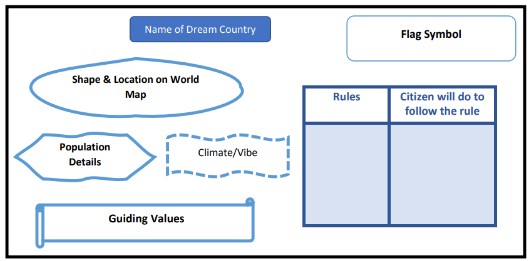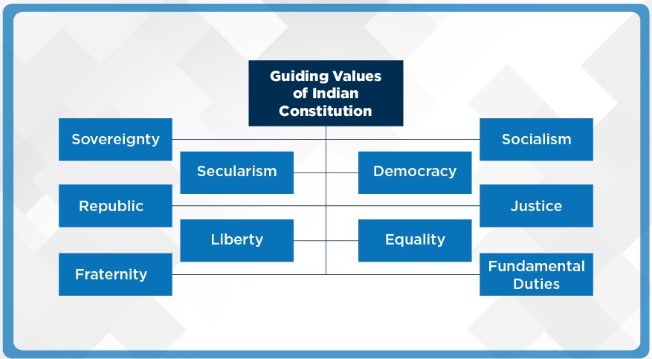

KLE August Activity – MY DREAM COUNTRY
OBJECTIVES
- Students will be able to recognise the essentials and guiding principles for a country.
- Students will be able to identify the meaning of constitution in brief by drafting rules for a country.
OUTCOMES
- Students will be able to describe their understanding of the constitution.
SKILLS AND VALUES
Skills - Communication, Problem-solving and Creativity
Values - Responsibility
SESSIONS’ OVERVIEW
| S. No. | Session Details | Estimated Time Required |
| 1 | Step 1: Introduction
Step 2: Group Activity |
45 Minutes |
| 2 | Step 3: Presentation
Step 4: Debrief of Activity |
45 Minutes |
MATERIAL REQUIRED
Notebooks, pens, chart paper/plain A4 size paper/blank papers (as per availability)
STEPS OF THE ACTIVITY
Session 1: For a 45 min session Step 1-2
Step 1 – Introduction
Estimated Time (10 Mins)
Teacher will ask the students the following questions:
- What are some of the rules we follow in school?
- Why do you think we need these rules?
- Do we also have any such rules for our country? Where are these rules written?
Teacher will then tell the students that in today’s activity, we will draft rules (constitution) for an imaginary dream country in groups.
Step 2 – Group Activity
Estimated Time (30 Mins)
1. Divide students into 4-6 groups depending on the class size ensuring that each group has 6-8 students. If the class size is large, teacher can divide into 7-8 groups.
2. Inform the students in their groups they will do the following:
a. Give name to their Dream country. Draw & design your country shape, flag (HW), where should it be located on the world map & describe about its general vibe/climate.Note: Tell students to make unique flag/symbols to avoid duplication with any country’s existing flag.
b. Define population of their country (how many people, composition in terms of gender – male/female)
c. List 2-3 values that we want everyone in the country to have. These values will guide to write the rules.
d. List 3-4 country rules that every citizen in the country must follow. Keep in mind, these rules will be applicable to every citizen of your country.
- To write these rules, use the phrase “Everyone has the right to…” (e.g., Everyone has the right to participate.).
- Each group to discuss these rules and can only write it down if everyone in the group agrees. The goal is not to have many rules but rules that everyone accepts.
- After listing the rule, ask what the citizen of the country will need to do so that the rule is followed. Use phrase like “Citizen should...” to frame these sentences (e.g., Citizen should give everyone opportunity to participate.
Some Examples
| Rules | Citizen will do to follow the rule |
| Everyone has the right to express an opinion. | Citizens should give everyone the right to express an opinion. |
| Everyone has the right to be treated fairly. | Citizen should treat everyone fairly. |
e. Keep the language of rules simple and specific.
(Annexure 1 can be shown or given to students. Students are free to present as per their creativity)
3. Inform the students they will get 20-25 minutes to do the task.
Note: Teacher can share the reference materials given in Annexure 2 like picture of World Map, guiding values of Indian constitution as per the need of class.
Homework:
Students can create flag/symbol for their country and bring it in next session along with the group activity task. Students will present their Dream country Group Task in next session.
Note: If for most of the group’s teacher observes that group activity needs more time, they can continue to do that in next session. If Presentation time falls short, then teacher can arrange it to be a Gallery Walk (display the charts & students walk around) in classroom to see each other’s Dream Country Presentation.
Teacher needs to pre-inform the date of the next session for students to bring completed homework on the activity day.
Session 2: For a 45 min session Step 3-4
Recap:
Teacher can begin the class by asking the students about the experience of doing the group work for dream country.
Step 3 – Group Presentation
Estimated Time (30 Mins)
- Teacher will invite the groups one by one to present their dream country Group Task to the class.
- Inform the students that each group will get 5 mins to present. (If number of groups is more than teacher will adjust the per group timings as per the number ensuring equal presentation time for all.)
- Other Students can ask questions to the presenting group after the presentation is completed by the group. Encourage students to ask questions like Why did you choose these particular rules? (Try picking different kind of rules from different groups, so that students get a chance to give and listen to maximum reasoning.)
- Teacher will then summarize the discussion with help of debrief questions.
Step 4 – Debrief of Activity
Estimated Time (10 Mins)
Ask students the following questions to debrief the activity:
- How was the experience of creating these rules for your country?
- What role did values play while framing rules?
- Who is responsible for making sure that everyone follows these rules?
- Why do you think it is important for a country to create rules? What do you think is the purpose of the rule book (Constitution)?
Reflection Sheets, Activity Report & Feedback Form
Teachers kindly fill in the feedback form, remind office bearers to fill activity report and remind students also to fill up the reflection sheets.
REFERENCE SECTION
Annexure 1 – Dream Country Presentation Template


Note: This is guiding template – students are free to present the above information as per their own creativity. Care to be taken that all points mentioned for the group task are covered.
Annexure 2 – Reference Materials
List of Guiding Values of Indian Constitution for Reference.
Students can also refer to Preamble given in their textbooks for reference.


Image Source: https://bpac.in/the-10-guiding-values-in-the-preamble-of-the-indian-constitution/
World Map Image for reference:


Image Source: https://www.123rf.com/photo_36235529_cartoon-world-map.html





